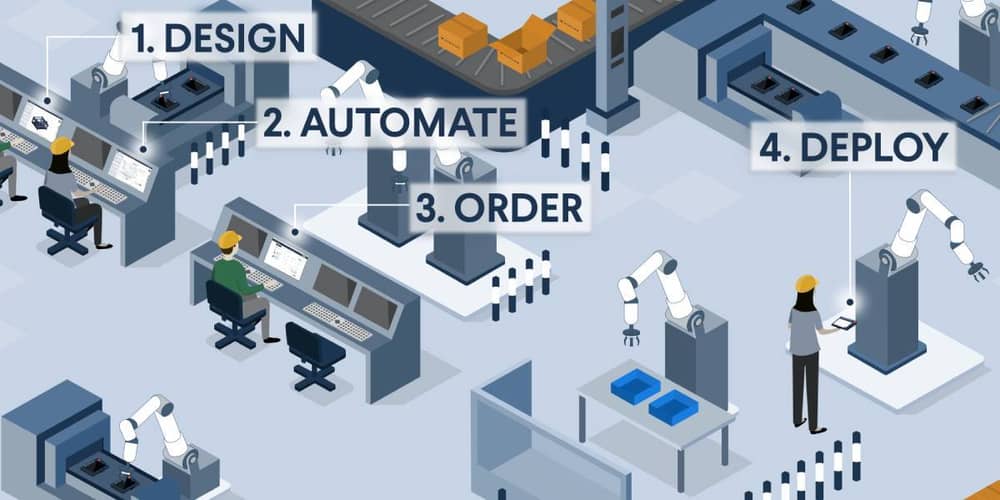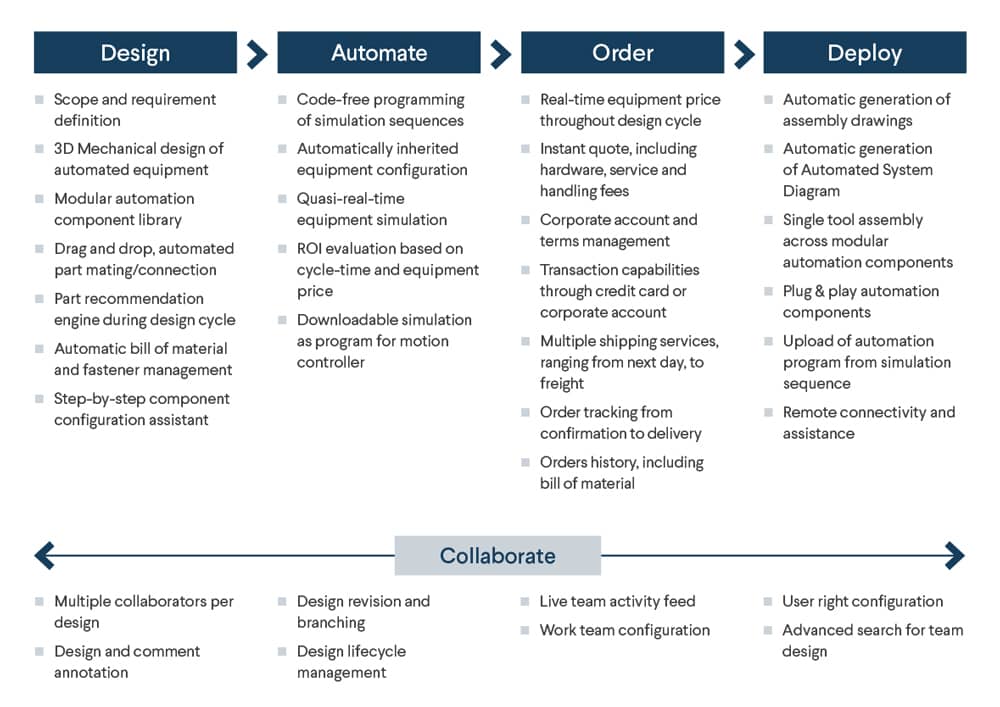
Manufacturing floors are like living organisms. No longer designed for 10+ year shelf lives, it is now common to replace, upgrade, or repurpose assembly lines and manufacturing equipment every 2-3 years.
The pace of new product introductions is accelerating, production capacities are readjusting to meet changing customer demands, and continuous improvement initiatives are always underway.
This rhythm of change is not compatible with the traditional way of deploying industrial automation technology. Suited for high-throughput production, high-priced industrial automation technologies often require the expertise of specialized system integrators to deploy, which increases project cost and lead time.
A new category of software—the manufacturing automation platform (MAP) —is democratizing access to industrial automation technologies. With a focus on ease of use, MAPs empower any manufacturing professional to become an automation specialist. Deployment is much faster, too, since automated systems can now be designed and commissioned entirely within one’s web browser.
For years, users have experienced the tribulations of configuring and integrating siloed solutions. Unlike traditional engineering software, though, MAPs blend many engineering software systems into a single digital environment, erasing the boundaries between the digital and physical worlds.
Project workload and duration are reduced from months to days, and the resulting savings (thanks to the reduced labor hours needed for design, procurement, and commissioning) often exceed 40%.
To better understand how a MAP creates value, let’s dissect the workflow of a typical industrial automation project from design to deployment.
Design
From defining requirements to pricing the 3D design
A MAP provides a design environment built for industrial automation projects, not generic product designs. The design cycle starts with defining the scope and requirements. Users can easily monitor hard and soft objectives, the project budget, and key milestones. They can act as high-level architects of the automated process (for example by dictating key steps and cycle time) and define a variety of technical specifications, like environmental conditions, HMI requirements, and connectivity with existing systems.
Taken holistically, the scope and requirements generate a “scope of work” that creates a digital roadmap for the project from design to commissioning. The “scope of work” can be shared electronically with design collaborators, or automatically added to any instant quote or order confirmation generated within the MAP. The user then converts these requirements into a fully functional and priced design.
Since MAPs are built for industrial automation, design work centers around selecting and combining individual components to create a complete system, often in the form of a 3D assembly. Automation components are typically modular or plug-and-play (see our previous article in the MAPs series ). Because the components are pre-selected for compatibility, MAPs can include smart design features that would not be possible in traditional 3D CAD software: automated part mating, real-time part recommendations, assisted component configurations, automatic bills of materials, real-time pricing, assembly-time estimates, and more.
All this contributes to a step-change reduction in design time compared to traditional 3D software. In most cases, MAP users can design an entire automated system in 2 to 8 hours.
How MAPs drive value at the design stage:
* Lower project risk, due to requirement-driven design
* Shorter design cycle, reduced from weeks to hours.
* Cost-optimized design, thanks to the visibility of real-time pricing.
Automate
From simulating in the cloud to programming on the factory floor
To validate the cycle time, users can leverage the system configurations generated by the 3D design to simulate the machine directly in their browser. Parameters like motor torque, timing belt linear gain, and conveyor speed are digitally inherited from the selected components, so it’s relatively quick to create a realistic simulation. Other variables, like input, output, and motion instructions, can be defined in a drag-and-drop interface.
With a simulation environment that is integrated into the 3D design environment, end users can quickly implement design changes and measure the impact on the simulation. Project ROI can be measured on the spot, with equipment price and machine cycle time displayed inside the MAP.
Once validated, the simulation (and its underlying code-free program) as well as the system configuration are easily transferred from the cloud-based MAP to the machine’s motion controller. As such, the traditional boundaries— between 3D design, programming, and simulation, and physically operating the automated equipment—are removed. Users can swiftly navigate from one step to the next in the same digital environment.
How MAPs drive value at the automate stage:
* Easy to use, simplifying the evaluation of automation projects.
* Straightforward calculations of project ROI and payback.
* Low-cost deployment, since it can be done directly by the end user.
Order
From generating instant quotes to shipping next-day
Using data from the modular components, 3D design, and user accounts, the MAP significantly shortens the procurement cycle from weeks to days. Price transparency throughout the design cycle means users can download an all-encompassing quote in real time. Industrial components, software for operating the equipment, and value-added services like assembly or commissioning support are all transparent—no need to wonder about hidden fees.
Buyers, who may not have played a role in designing the equipment, can access the design to purchase and process the transaction online. Several shipping services are available, from standard delivery to next-day shipping. As on most e-commerce sites, orders can be tracked by any user with access to the team’s account.
How MAPs drive value at the order stage:
* Transparent and itemized pricing.
* Shorter procurement cycle, reduced from days to minutes.
* Real-time order preparation and delivery tracking.
Deploy
From receiving the order to the fully commissioned equipment
Commissioning automated equipment has never been easy. This is where unresolved compatibility issues, leap-of-faith design choices, and overlooked laws of physics typically reveal themselves.
MAPs reduce these risks. All components available on the MAP are held to certain mechanical standards; all automation components are tested for plug-and-play integration; and automated equipment designed in the MAP is often shipped in a flat-pack box and able to be assembled using a single tool.
But a MAP goes beyond modular components and easy assembly. It provides automatically generated assembly drawings, a complete bill of materials, and a diagram of the automation system, all of which greatly simplify the commissioning process.
As for on-site deployment: to initiate site acceptance, an automation program can be downloaded directly from the MAP and loaded onto the machine’s motion controller. If the user needs more help, the MAP’s support team can remotely access the design file and remotely connect to the equipment (upon receiving authorization, of course) to provide direct assistance.
How MAPs drive value at the deploy stage:
* Risk-free commissioning with pre-tested components.
* Low-cost, self-serve commissioning by the end user.
Collaborate
Reduce time from design to deploy
Because all phases from design to deployment take place in the same digital environment, records are available to anyone who needs them. MAPs also eliminate wait time transferring a design from the CAD to PLC programming software or procurement software, which saves time throughout the workflow.
There are often multiple contributing users throughout the design-to-deployment phase. For example, the designer is not always the purchaser, and the purchaser will rarely do the commissioning. Each user, however, relies on the data derived from the previous phase.
With a MAP, users accessing their team portal can see ongoing and historical activity feeds; search, view and open designs across their company; and configure their colleagues’ access rights. Moreover, the cloud nature of MAP software makes it easy to collaborate on designs by adding branching revisions and inserting comments.
While “collaborate” is not an official step in the manufacturing automation workflow, it is instrumental in uniting the design-to-deployment phases in a single digital thread.
How MAPs drive value at the collaboration stage:
* Reduced end-to-end project time, due to the single digital environment.
* Gain transparency, with the ability to see who’s doing what at each stage of the project.
Throughout the commissioning process—design, automate, order, and deploy—MAPs incorporate features that speed up industrial automation projects. The figure below provides a summary of those features:

A new software category for a new era of industrial automation
MAPs, as a type of software, focus on empowering manufacturing professionals to drive industrial automation projects forward. With ease and speed. The MAP democratizes access to industrial automation technologies, diversifying the industry beyond high-throughput manufacturing plants. This not only enables high-mix factories to remain competitive by adopting modular, low-cost automation but also provides a pathway to transform today’s manufacturing workforce into tomorrow’s automation specialists.
To learn more about MAPs, and why they’re emerging now, read our article: The adoption of advanced manufacturing depends on democratization, not technology.
